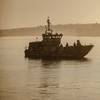U.S. Navy and Republic of Singapore navy (RSN) sailors and officers shared their views on terrorism and maritime security during a seminar on the subjects May 31 at the RSN’s Changi Naval Base.
The seminar included a presentation on the U.S. Navy’s 21st century maritime strategy by a visiting U.S. Naval War College (NWC) professor here in support of exercise Cooperation Afloat Readiness and Training (CARAT), a series of bilateral exercises held annually throughout Southeast Asia.
“My visit is twofold. I hope we can have a dialogue so I learn from the experts who live in this region of the world,” said Jeffrey Norwitz, professor, National Security Decision Making at the NWC.
Norwitz, who is also a 22-year Naval Criminal Investigative Service agent, teaches the only terrorism course at the school. He began the hourlong seminar explaining the U.S. Navy’s Sea Power 21 initiative.
“Sea Power 21 is a philosophy based on four pillars – Sea Strike, Sea Shield, Sea Basing and ForceNet,” Norwitz explained.
Bringing the topic closer to Singapore, Norwitz initiated a discussion of piracy in the Strait of Malacca and in the region. The enhancement of maritime security capabilities to combat piracy and other transnational crimes at sea is one of CARAT’s focal points.
“From our perspective, we’d love to work with everyone to ensure the security of the immediate maritime neighborhood around us,” said RSN Fleet Commander, Col. Tan Kai Hoe from his seat in the front row. “The more resources we can muster, the more we can address the issues.”
Adding to the dialogue, Rear Adm. William Burke, commander of Task Force 73 and CARAT’s executive agent, discussed his views on the topic.
“We’re not providing security in the Strait of Malacca,” he emphasized. “Nations that border the Strait of Malacca are taking care of maritime security in that area. We’re in this exercise working with Southeast Asian nations, including Singapore, to address needs they may have and share information to maintain maritime security."
From seaman to admiral, the seminar was geared towards maritime security awareness.
“This seminar gave me some perspective on why it’s important for us to come here for CARAT,” said U.S. Coast Guard Seaman Jennifer Jenkins from the cutter USCGC Sherman (WHEC 720), one of five CARAT task group ships.
Singapore is the first phase of CARAT, and exercises with Brunei, Indonesia, Malaysia, the Philippines, and Thailand will round out the three-month series.
The U.S. CARAT task group, under the leadership of Capt. Al Collins, who is commander of Destroyer Squadron 1, is made up of the dock landing ship USS Tortuga (LSD 46), guided-missile destroyer USS Hopper (DDG 70), guided-missile frigate USS Crommelin (FFG 37), Coast Guard cutter Sherman, and the rescue and salvage ship USS Salvor (ARS 52). Other elements, including P-3C Orion and SH-60 Seahawk aircraft from Patrol Squadron (VP) 46 and Helicopter Anti-Submarine Squadron (Light) (HSL) 37; Mobile Security Squadron 7; the Naval Criminal Investigative Service; and a U.S. Coast Guard Training team are also taking part in CARAT.
By Senior Chief Mass Communication Specialist Melinda Larson, Destroyer Squadron 1 Public Affairs
source: NavNews
Featured videos

Inside the Electrified Truckable Tug

Tracking Foreign Vessels Working in the U.S. Jones Act Market

Unlock Onboard Data Efficiencies
Subscribe for
Maritime Reporter E-News
Maritime Reporter E-News is the maritime industry's largest circulation and most authoritative ENews Service, delivered to your Email five times per week









